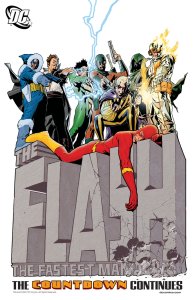![[Flash Logo]](https://hyperborea.org/journal/wp-content/uploads/2007/01/emblem.png) A post on the Comic Bloc Forums the other day made me think about the question: Which Flash had the longest solo career?
A post on the Comic Bloc Forums the other day made me think about the question: Which Flash had the longest solo career?
It depends on how you measure it. The original Flash, Jay Garrick, has of course been around the longest: 1940–today. He’s got more than 65 years on his successors. But a more useful question is: How long was each Flash around before DC replaced him as “the” Flash?
The easiest measurement: years in publication.
| Name | Start | End | Span | |
|---|---|---|---|---|
| Jay Garrick | 1940 | – | 1951 | 11 years* |
| Barry Allen | 1956 | – | 1986 | 30 years |
| Wally West | 1986 | – | 2006 | 20 years |
| Bart Allen | 2006 | just starting |
Barry is the clear winner by this measure, at three times Jay’s career, and 1½ times Wally’s.
But what about sheer number of comics**?
Jay Garrick:
104 issues of Flash Comics
32 issues of All-Flash
29 issues of solo stories in Comic Cavalcade
165 issues
Barry Allen:
4 issues of Showcase
246 issues of Flash (numbered #105–#350)
1 Flash Annual
1 Flash Spectacular
252 issues
Wally West:
232 issues of Flash (numbered #1–#230, #0, and #1,000,000)
13 Flash Annuals
3 Flash Secret Files
2 Flash graphic novels: Iron Heights and Time Flies
1 Flash: Our Worlds At War (essentially an annual)
251 issues
By this measurement, Wally has nearly caught up, and is just one issue behind Barry. (Barry’s book started out bimonthly) Even dropping all the related books and sticking just with Flash and its annuals, we’re at 247 to 245.
Of course, we could take other measurements, too—like story count. Golden-Age and Silver-Age stories were typically about 12 pages long instead of 22. There would be three or four stories in an issue of All-Flash, and two in early issues of The Flash. (Of course, in the 1960s and 1970s, the backup story was sometimes a reprint.) While researching my website, I’ve indexed all of Barry’s run and a good chunk of Jay’s (filling in the gaps from the GCD) and I count 208 Golden-Age Flash stories and 319 Silver/Bronze-Age Flash stories. Wally is stuck in the middle with one story per issue.
Of course, this still doesn’t count All-Star, Justice League, or big company crossover books….
*Flash Comics was canceled in 1949, but the Flash continued to appear with the Justice Society in All-Star Comics through 1951.
**I’m not including Jay’s Flash Comics Miniature Edition, since it was only available taped to a cereal box, or Wally’s Flash #½, since it was a mail-in order. I’m also not including group books like the Flash 50th Anniversary Special, Speed Force, any of the Flash 80-page or 100-page giants that weren’t numbered within the main series. And The Life Story of the Flash and Flash/Green Lantern: The Brave and the Bold are both flashback books (pun not intended).



I don’t know much about The Flash other than the TV show, and that was Barry Allen. 🙂
One thing to note is that while Wally, as Kid Flash, was not THE Flash, he had, essentially, all the same abilities (particularly early in Barry’s run), split several issues with Barry, and appeared only a few stories into Barry’s run… so in terms of ongoing tenure… Wally might be more prominent as a member of the Flash family.
If we consider non-Flash books, such as Justice League, Justice League Elite, crossovers, etc. As well as other media such as the Timm cartoons, there’s an argument for Wally being THE Flash for more people across more mediums as well.
True, but I’m not counting Wally’s years/books before he became the Flash for the same reason I’m not counting Jay’s years/books after Barry appeared. If we go with that, all it tells us is who appeared first.
You’re probably right about expanding it to all DCU books, though. Crossovers are more frequent in the last 20-30 years than they were during the Silver or Bronze Age, and Barry and Wally were each more or less continually in one Justice League book or another (barring the first 2 years of Wally’s solo book), so in terms of total page count, Wally would probably win. The Justice League cartoon would clinch it.